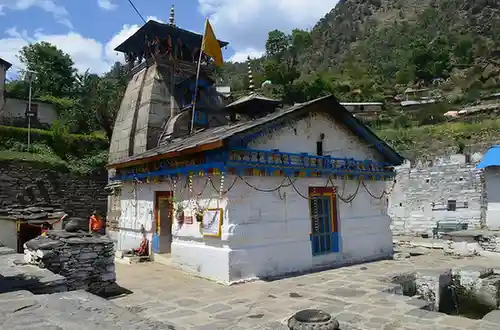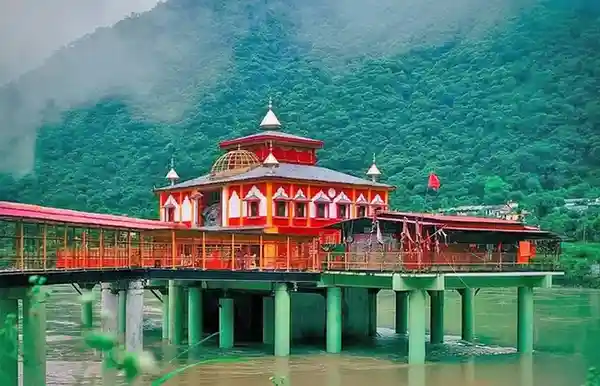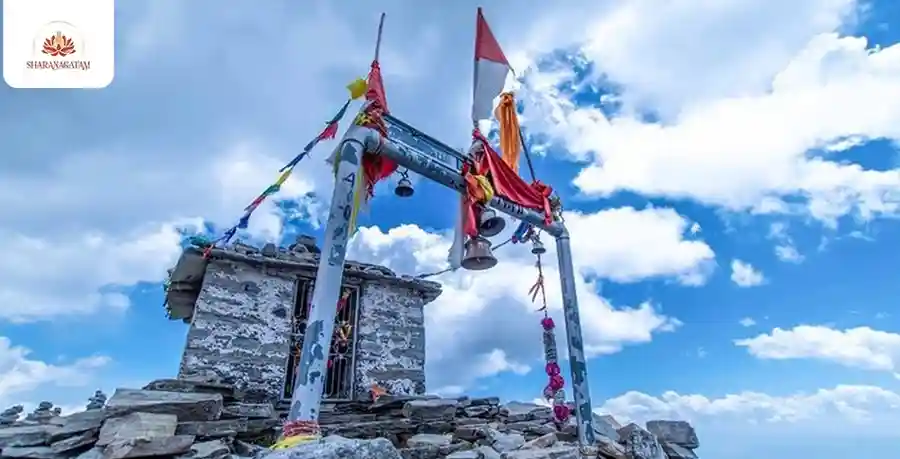Top 10 Must Visit Temples on Char Dham Journey: India is renowned for its spiritual heritage and timeless pilgrimages. Among these, the Char Dham Yatra in Uttarakhand holds a special place in the hearts of millions of devotees. This sacred circuit, primarily comprising Yamunotri, Gangotri, Kedarnath, and Badrinath, is more than just a journey; it’s a transformative experience that deepens one’s inner connection and spiritual understanding. In addition to these main temples, the area also contains a number of other temples which represent the ancient wisdom and cultural heritage of India.
Table of Contents
The Char Dham Yatra – Must Visit Temples on Char Dham Journey
The Char Dham Yatra typically includes tours of four hallowed locations in the Himalayas—Yamunotri, Gangotri, Kedarnath, and Badrinath. These temples are more than physical structures; they are repositories of spiritual energy, myths, and traditions that date back millennia.
Though these four locations are the center of the pilgrimage, many other temples in the area provide another layer of mystery and spiritual understanding. Pilgrims tend to stay for additional days to discover these lesser-known but equally sacred temples. These secondary locations offer a chance to immerse themselves in local life, discover ancient customs, and find moments of peaceful contemplation amidst nature’s beauty.
1. Yamunotri Temple – The Source of Purity
Location & Significance:
Situated in the Uttarkashi district at an elevation of 3,293 meters, Yamunotri is the source of the holy Yamuna River. The temple, which is dedicated to Goddess Yamuna, is said to be the place where the divine river first appeared. Devotees come to Yamunotri to cleanse themselves and wash away their sins by taking a sacred dip in the nearby thermal springs.
History & Legends:
According to local lore, the sacred springs in Yamunotri have medicinal properties and are imbued with healing energy. Ancient scriptures mention the temple as a place where sages once meditated, seeking divine guidance. The journey to Yamunotri, which includes a moderate 6 km trek from Janki Chatti, is seen as a physical metaphor for the purification of the mind and soul.
Pilgrim Tips:
- Begin your hike early in the morning for a serene experience and to beat the crowds.
- Pack warm clothes as temperatures at this height may fall, even during summer.
- Be respectful of local traditions by joining the aarti (prayer ceremony) at the temple.
Local Insight:
Several veteran pilgrims recommend taking some peaceful time beside the thermal springs to soak up the spiritual vibe of the area. The gentle gurgle of the water and the old chants at the temple serve to quiet the mind and provide a moment of contemplation.
2. Gangotri Temple – The Birthplace of the Ganga
Location & Significance:
Dedicated to Goddess Ganga, the Gangotri Temple is situated in the district of Uttarkashi at an altitude of 3,100 meters. Being among the significant religious hubs, the temple receives thousands of devotees who would love to behold the sacred river’s untainted water.
History & Legends
Gangotri legends are as old as centuries, telling about how the goddess Ganga came down to earth from heaven to bestow her grace on humanity. The temple with its stone carvings dating back to times immemorial and peaceful surroundings is a reflection of the heavenly bonding of nature and religion. Bathing in the Ganges during ritual is said to wash away one’s soul and bestow divine grace.
Pilgrim Tips
- Make plans to see early in the morning when nature’s beauty is lifted by the soft light.
- The time while boat rides along the Ganges may be utilized for silent reflections.
- Avoid desecrating the holiness of the location through boisterous conversation and disturbances.
- Local guides suggest that you pair your trip to Gangotri with a short trek along the riverbank. The hypnotic flow of the Ganges, with the sound of the water and distant chanting, is a profoundly moving experience.
3. Kedarnath Temple – The Abode of Shiva
Location & Significance: Must Visit Temples on Char Dham Journey
Situated at an altitude of 3,583 meters within the Rudraprayag district, Kedarnath Temple is among the most revered temples of Hinduism. Consecrated to Lord Shiva, it is one of the twelve Jyotirlingas, symbolizing the union of mountain and divine power of the lord.
History & Legends:
Kedarnath is tied up with epic myths of the Mahabharata. It is believed that during the great battle, Kedarnath was the refuge of faithless ones, and the temple has endured acts of nature, such as destructive floods in 2013. Its survival has always been viewed as miraculous, which is proof of the temple’s divine sanctuary.
Pilgrim Tips:
- The hike from Gaurikund to Kedarnath is difficult; prepare yourself physically and mentally.
- Bring enough water and snacks, and have regular rest stops to adapt to the steep altitude.
- Opt for a local guide who has knowledge of the landscape and also safety measures.
- Several pilgrims point out that though the journey is tiring, the spiritual satisfaction of arriving at Kedarnath is well worth it. The temple ambiance, the resonating mantras, and the panoramic Himalayan landscape provide an exclusive feeling of completeness that remains long after you’ve returned.
4. Badrinath Temple – The Abode of Vishnu
Location & Significance: Must Visit Temples on Char Dham Journey
Located at 3,133 meters above the Chamoli district, Badrinath Temple belongs to Lord Vishnu. It is a venerated shrine central to the pilgrimage of Char Dham and worshipped as a site where worshipers can achieve divine protection and spiritual salvation.
History & Legends:
Badrinath is where miraculous things have been happening for centuries. It is said to be a doorway to the spiritual world, and the temple’s tranquil location on the banks of the Alaknanda River only underscores the universal harmony between nature and divinity. Epic wars, divine avatars, and primeval rituals are what fill the atmosphere around this temple.
Pilgrim Tips:
- Visit early morning to experience the calm, serene ambiance and miss the heat of the day.
- Take part in the morning aarti, when the temple erupts with spiritual songs and oil lamps’ gentle glow.
- Avoid disrupting the sacred atmosphere of the temple by keeping away from showy attire and talking during prayer times.
Local Insight:
Local pilgrims highlight that Badrinath is not merely a temple—it is a spiritual retreat where the mind, body, and soul are harmonized. Sit by the river and ponder over the significance of your journey while you observe the serene flow of water.
5. Tungnath Temple – The Highest Shiva Temple
Location & Significance: Must Visit Temples on Char Dham Journey
Located in the Rudraprayag district at an altitude of 3,680 meters, Tungnath Temple is considered the highest Shiva temple in the world and is part of the Panch Kedar. It stands as a beacon of spiritual dedication amid the vast Himalayan expanse.
History & Legends:
Tungnath is enveloped by myth and nature. It is said that Lord Shiva hid here to flee the worldly tumult, and the temple’s inaccessible location adds to its mystique. The trek to Tungnath, overlooking the Himalayas, has become an essential part of the journey.
Pilgrim Tips:
- With its high altitude, it becomes necessary to acclimatize well.
- Take a light jacket and trekking poles to help with the uneven surface.
- Take regular breaks at marked view points to catch your breath and enjoy the stunning vistas.
Local Insight:
Pilgrims have been known to say that the trek to Tungnath is as spiritually enriching as the place itself. The fresh mountain air, pristine landscapes, and sense of remoteness lead to a meditative atmosphere that is difficult to find elsewhere.
6. Triyuginarayan Temple – Must Visit Temples on Char Dham Journey

Location & Significance:
Located in the Rudraprayag district, Triyuginarayan Temple is famous as the place where Lord Shiva and Goddess Parvati are said to have got married. The temple is a symbol of wedded bliss and forever love.
History & Legends:
According to ancient legends, this temple marks the spot where a sacred fire burned continuously as a testament to the divine union. Over time, Triyuginarayan has become a popular destination for couples seeking blessings for a harmonious marriage, as well as for families desiring spiritual unity.
Pilgrim Tips:
- This temple is less crowded compared to some other major sites, offering an intimate, reflective experience.
- It is an ideal destination for those seeking guidance on relationships and family values.
- Engage with the local guides to understand the legends and rituals associated with the temple for a richer experience.
Local Insight:
Many visitors express that Triyuginarayan provides not only spiritual healing but also practical insights for living a balanced life. Spending time here can be deeply transformative, especially for those at crossroads in their personal relationships.
7. Kalimath Temple – The Isolated Prayer to Goddess Kali
Location & Significance:
Situated in the hilly regions of Rudraprayag, Kalimath Temple is devoted to Goddess Kali, one of the 108 Shakti Peethas. The temple is special as the god is prayed to in a pit, symbolizing the formless, mystical figure of the goddess.
History & Legends:
Kalimath worship tradition goes centuries back in time, with local folklore painting it as a site where divine power and uncultivated nature intersect. Pilgrims visit this site not only to beg for blessings but also to test their inner strength and resilience by entering into its enigmatic ambiance.
Pilgrim Tips:
- Be ready for challenging terrain while trekking to the temple.
- Honour the distinctive rituals that are specific to Goddess Kali, which might vary from the common temple traditions.
- Keep a respectful silence and meditative mind when in the precincts of the temple.
Local Insight:
Locals opine that Kalimath is not for the weak hearted. It is a temple in which facing nature’s raw force is part of the spiritual test, and people who emerge having braved it often find new meaning in their lives.
8. Dhari Devi Temple – Protector of the Holy Waters

Location & Significance:
Sitting atop a rock of the Alaknanda River in the Rudraprayag district, Dhari Devi Temple is one devoted to Goddess Dhari. It is supposed to be protected by the goddess from natural disasters as well as the welfare of the inhabitants.
History & Legends
The temple is shrouded in legend, with ancient writings recounting miraculous occurrences related to its presence. Pilgrims who make the journey to Dhari Devi frequently comment on an unexplainable sense of security and protection that pervades the temple, a reflection of the goddess’s protective power.
Pilgrim Tips:
- The temple’s position on the river requires watchful walking; tread carefully on slippery surfaces.
- Relish the sound of the flowing water, which contributes to the temple’s contemplative atmosphere.
- Make your offerings with a humble mind and shed any negativity.
Local Insight:
According to local devotees, spending just a few minutes in prayer at Dhari Devi can impart great inner peace. The combination of water, rock, and spirituality here is a specially leveling experience.
9. Lakhamandal Temple – A Memory from the Mahabharata
Location & Significance:
Situated in the picturesque Dehradun district, Lakhamandal Temple is rich in ancient history and mythology. It has been frequently associated with the stories of the Mahabharata and is said to have been founded by the Pandavas.
History & Legends:
The temple complex contains many shiva lingas and ancient artifacts that speak of times past. Pilgrims do not only visit to pray, but to soak in the rich historical accounts which resonate the splendor of the Mahabharata.
Pilgrim Tips:
- Spend time visiting the temple complex and soaking in its historical atmosphere.
- Feel free to connect with local guides who can tell the stories and myths surrounding the temple to enhance a better insight.
- Treat the ancient inscriptions and artifacts with respect, as precious connections to India’s glorious past.
Local Insight:
Numerous travelers have found that the historical charm of Lakhamandal adds to their spiritual experience. The temple serves as a reminder that history and faith are not separate, and discovering these ancient tales can enlighten and inspire the pilgrim’s heart.
10. Mana Village Temples – The Last Sanctuary
Location & Significance:
Mana Village, located in the Chamoli district, is referred to as the last Indian village on the way to the Tibetan border. The village and the surrounding region are inhabited by various temples and ancient caves like Vyas Gufa and Ganesh Gufa, where legends talk of sage Vyas and Lord Ganesha.
History & Legends
Mana is shrouded in legend and is among the most secluded and unspoiled parts of India. The temples and caves here have been mute spectators to centuries of devotional meditation and prayer. They present pilgrims with a chance to experience spirituality in its unpolluted form, untainted by the more commercialized pilgrimage paths.
Pilgrim Tips:
- Look for a rural, genuine experience.
- The trip to Mana is a rough ride, so get ready with tough transportation and additional provisions.
- Don’t be afraid of Mana’s ruggedness and remoteness—accept the simplicity and isolation and use it as an opportunity to think deeply and restore your inner self.
Local Insight:
Locals hold Mana as a holy sanctuary that has not changed over generations. Its peaceful, unspoiled surroundings and the genuine spirituality of its practices are a deeply emotional place for many pilgrims.
Practical Details for Your Pilgrimage with Sharanagatam
Organizing Your Itinerary: Must Visit Temples on Char Dham Journey
A well-planned Char Dham Yatra is a must. With Sharanagatam’s professional guidance, you can rest assured that every detail of your pilgrimage is well planned and customized.
- Personalized Itineraries: Sharanagatam assists you in designing an itinerary according to your fitness, time, and spiritual aspirations.
- Travel Arrangements: They arrange for transportation (private cars, buses, or even helicopter services) to facilitate easy passage between remote locations.
- Accommodations: From humble dharamshalas to cozy guest houses, your accommodations are taken care of to offer rest and contemplation after exhausting days of travel.
- Health and Safety: Pilgrimages in the high-altitude Himalayas require attention to your health and well-being.
- Physical Preparation: Regular physical exercise and practice trekking prior to ensuring building up stamina.
- Altitude Acclimatization: Take a few days at a moderate altitude prior to traveling further into higher altitudes.
- Medical Kit and Insurance: Take a minimum first-aid kit, and any medication prescribed by your doctor, and obtain comprehensive travel insurance covering high-altitude trekking.
Spiritual and Mental Preparation: Must Visit Temples on Char Dham Journey
The Char Dham Yatra is as much a spiritual and mental journey as it is physical.
Mindfulness Practices: Include meditation or yoga daily in your routine before and during your pilgrimage.
- Setting Intentions: Clearly state what you hope to gain from this pilgrimage—be it inner peace, personal growth, or profound spiritual understanding.
- Reflection: Maintain a travel journal to record your daily life, thoughts, and feelings during the pilgrimage.
Local Etiquette and Cultural Sensitivity: Must Visit Temples on Char Dham Journey
Respecting the local traditions can make your pilgrimage much more enjoyable.
- Dress Modestly: Maintain modest dressing, particularly when going to temples.
- Observe Rituals: Join in on prayers and rituals with an honest heart.
- Respect the Environment: Practice eco-friendly habits by bringing refillable water bottles and making sure you leave as little waste as possible behind.
Why Book Your Pilgrimage with Sharanagatam?
Sharanagatam is committed to making your Char Dham Yatra safe and spiritually rewarding. Their experienced staff is familiar with the intricacies of the pilgrimage and can assist in customizing each step of your journey to your specifications.
Key Advantages:
- Tailored Itineraries: Every pilgrimage is unique. Sharanagatam customizes your itinerary based on your interests, physical ability, and spiritual goals.
- Experienced Guides: Local experts and guides help navigate challenging routes and provide deep insights into the historical and spiritual significance of each temple.
- Comfortable Accommodations: With a wide range of lodging options—from rustic dharamshalas to cozy guest houses—you can rest assured that your comfort is prioritized.
- Complete Support: From transportation to guided tours and health safety, Sharanagatam has all the facets of your travel covered so you can concentrate fully on your spiritual experience.
For those who are willing to undertake an unforgettable pilgrimage, Sharanagatam is your partner of choice.
Conclusion: Must Visit Temples on Char Dham Journey
The Char Dham Yatra is a lifetime religious pilgrimage that presents unmatched possibilities of self-realization and divine contact. Whether it is the purifying waters of Yamunotri, the sacred flow of the Ganges at Gangotri, the majestic presence of Kedarnath, or the peaceful refuge of Badrinath, each temple on this pilgrimage has its own special key to spiritual transformation.
Our pilgrimage through the top 10 temples—from Yamunotri’s mystical charm to Mana Village’s isolated shrines—unveils the rich brocade of faith, history, and nature that characterizes this pilgrimage. Every temple presents not just its own message of spirituality but also entices you to become a part of a legacy of worship that has been tended for centuries.
The pilgrimage is demanding and transformative. Through attentive physical conditioning, mindful preparation, and sensitive approach to local culture, you can wholeheartedly enjoy the challenges and benefits of the yatra. Local culture’s insights offered and the professional guidance of Sharanagatam guarantee that your pilgrimage will be unproblematic, secure, and profoundly rewarding.
Sharanagatam’s specially curated pilgrimage packages make the whole process—travel bookings and guided tours, accommodation and ground support—easy for you to focus solely on your inner journey and spiritual evolution. Their dedication to quality and personalized service turns what could be an intimidating expedition into a well-planned and inspiring experience.
As you get ready for your divine pilgrimage, be assured that each step you take brings you nearer to discernment, inner peace, and closer to the divine. The Himalayan tranquility, the eternally timeless ambience of these ancient temples, and the reverential practices of yesteryear beckon you. Let the divine power lead you, and may your Char Dham Yatra be etched into your memory as one of great change and spiritual awakening.
Now is the time to prepare for pilgrimage with confidence. With Sharanagatam to guide you, you can walk this spiritual journey with every detail attended to. Book your bags, declare your intentions, and enter a world where the divine meets sublime nature.
May your path be safe, your heart full of devotion, and your spirit elevated. Happy pilgrimage, and may each temple you see light your way to inner peace.
Frequently Asked Questions: Must Visit Temples on Char Dham Journey
1. What is the Char Dham Yatra, after all?
The Char Dham Yatra is a sacred pilgrimage circuit in Uttarakhand comprising a visit to four holy places—Yamunotri, Gangotri, Kedarnath, and Badrinath. They are extremely auspicious places to visit, and the pilgrimage is considered to cleanse the soul and give spiritual merit.
2. Why must I visit these top 10 temples?
Although the main Char Dham destinations are the spine of the pilgrimage, numerous other temples in the area, including Tungnath, Triyuginarayan, and Mana Village temples, add to the experience by presenting special spiritual experiences and historical significance. They add a better picture of India’s divine heritage and also give pilgrims opportunities to be alone and to meditate away from the masses.
3. At what time should the Char Dham Yatra be done?
The best time to go for the trip is the summer season—roughly between May and June or September and October. The climate is fine during these months, and the routes are open. Don’t visit during the monsoon season as the weather conditions are uncertain, and landslides may occur. Also, winter will make the trip extremely difficult.
4. How does Sharanagatam help in planning the pilgrimage?
Sharanagatam is an expert in designing bespoke pilgrimage packages for the Char Dham Yatra. Their packages offer customized itineraries, secure modes of transportation, comfortable stays (between dharamshalas and boutique guest houses), and knowledgeable local guides providing historical and spiritual knowledge at every temple. This all-around support ensures that each component of your trip is well taken care of, so you can immerse yourself in your spiritual journey.

